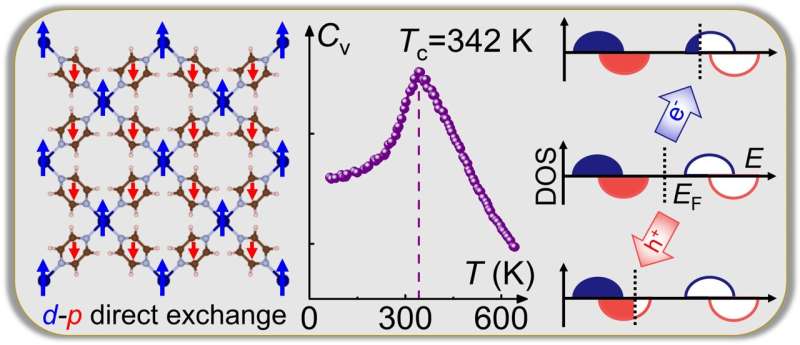On the left, a strong d-p direct exchange magnetic interaction exists between Cr cations and pyrazine radicals. In the center, the Curie temperature Tc is displayed. On the right shows that the Cr(pyrazine)2 monolayer is an intrinsic bipolar magnetic semiconductor where electrical doping can induce half-metallic conduction with controllable spin-polarization direction. Credit: Xiangyang Li and Xingxing Li.
Two dimensional (2D) magnetic semiconductors, integrating semiconductivity, ferromagnetism and low dimensionality, serve as the cornerstone for high-speed nanospintronic devices. However, the practical applications of nowadays 2D magnetic semiconductors face two key problems: the rather low magnetic Curie temperature compared to room temperature, and the lack of a simple and efficient method to control the carrier's spin polarization direction. Thus, exploring 2D magnetic semiconductors with room temperature magnetic ordering and controllable spin polarization is highly desirable.
On the one hand, in order to raise the magnetic Curie temperature to room temperature, Prof. Jinlong Yang's research group has previously proposed to introduce a type of strong d-p direct ferrimagnetic exchange interaction between transition metal cations and magnetic organic linker radical anions (see below, left image) in rectangular 2D organometallic lattices such as Cr(pentalene)2 and Cr(DPP)2. However, up to now, their experimental realization still keeps as an open question. Also, the control of spin polarization has not been achieved therein.
On the other hand, in order to realize direct control of carrier's spin polarization simply by electrical gating, Prof. Jinlong Yang's research group has previously proposed a novel class of spintronic materials named bipolar magnetic semiconductors (BMS), which can provide completely spin polarized currents with the spin polarization direction reversible by altering the polarity of applied voltage gate. It is worth mentioning that the most promising 2D material with BMS function is our designed 2D MnPSe3 nanosheets, where spin-polarization directions are opposite for electron and hole doping, and can be controlled by applying an external voltage gate. However, the ground magnetic state of 2D MnPSe3 is antiferromagnetic and should be doped to become a ferromagnetic BMS. Moreover, the magnetic Curie temperature under doping is low (up to 206 K), far from practical application.
Here, by marriage of our recently proposed d-p direct ferrimagnetic exchange scheme and the concept of bipolar magnetic semiconductors (BMS), Prof. Jinlong Yang's research group has made a significant step forward and realized a 2D intrinsic BMS material with room temperature ferrimagnetic ordering and electrically controllable spin polarization by exfoliating the recently synthesized organometallic layered crystal Li0.7[Cr(pyz)2]Cl0.7·0.25(THF) (pyz = pyrazine, THF = tetrahydrofuran). The feasibility of exfoliation is confirmed by the rather low exfoliation energy of 0.27 J/m2, even smaller than that of graphite. In exfoliated Cr(pyz)2 monolayer, each pyrazine ring grabs one electron from the Cr atom to become a radical anion, then a strong d-p direct exchange magnetic interaction emerges between Cr cations and pyrazine radicals, resulting in room temperature ferrimagnetism with a Curie temperature of 342 K (see below, center image). Moreover, Cr(pyz)2 monolayer is revealed to be an intrinsic bipolar magnetic semiconductor where electrical doping can induce half-metallic conduction with controllable spin-polarization direction (see below, right image).
The significance of the designed bipolar magnetic semiconductor (BMS), i.e. Cr(pyz)2 monolayer sheet, is summarized as follows:
- Raising the magnetic Curie temperature of bipolar magnetic semiconductor (BMS) to room temperature.
- Achieving direct control of carrier's spin polarization simply by electrical gating.
- Easy preparation by mechanical exfoliation.
Such kind of organometallic ferrimagnetic semiconductors not only provide a new opportunity to achieve high-Tc 2D magnetic semiconductors, but also has great potential in the design of electrically controlled nanospintronic devices.
More information: Xiangyang Li et al, Two-dimensional bipolar magnetic semiconductors with high Curie-temperature and electrically controllable spin polarization realized in exfoliated Cr(pyrazine)2 monolayers, Science China Chemistry (2021). DOI: 10.1007/s11426-021-1160-7
Provided by Science China Press
























